
A volume which may be quite literally unique has been selected for a sample display, here, of the University's desire to digitize the treasures in The Gonzaga Collection. The Dominican Missal of 1521 is not otherwise attested; the copy at Gonzaga University may be the only surviving one from this deluxe edition. Thus, it is a fine choice for showing the value of digitizing important works in order to make them available for scholarly study and the enjoyment of all.
This particular work is, moreover, an elegant example of the bookmakers' art. The text itself is rubricated, with focal letters and passages printed in red (Latin: ruber). A wealth of woodcuts provide "most beautiful pictures" (pulcherrimis figuris). Woodcuts fill the entire opening at the start of major feasts (in capite missarum festivitatum), such as Palm Sunday (fols. 63v-64). Woodcut initials (ca. 1 1/8" high) begin several texts, and woodcut illustrations (ca. 2 3/8" high) are found at the head of Gospel lections. In addition, portrait-woodcuts of the evangelists and the Apostle Paul can stand beside verses taken from their writings, and portrait-woodcuts of specific saints appear beside prayers mentioning them. For Christmas, special initial woodcuts were used, depicting Christmas scenes. Gregorian chant in the style used by the Dominicans is recorded in this volume. This missal also records valuable evidence for the Christian understanding and affirmation of women. The volume was clearly valued, for it was rebound with care, with skillful, colorful marbling on the slipcase, the book covers, and the endpapers.
Currently Gonzaga University is entering full bibliographic records for all volumes in The Gonzaga Collection into its library database, Voyager, and also into the international library database, WorldCat. As of May 31, 2009, bibliographic records for 75% of the collection have been entered into these databases. Once electronic records exist for all of the titles, then it will be possible to undertake a true digitizing project, for such a project requires the bibliographic "metadata" as part of each image. A high-quality digital camera was used for taking the images shown below.1 In order to digitize whole books from The Gonzaga Collection additional materials will be needed, including specialized software. Many valuable works will be made widely accessible through digitization. For instance, the Bruno Psalter, the Roman Missal of 1484, the 1518 edition of St. Thomas, the Dominican Missal, and the Opera Omnia of Martin Luther. Some of the volumes to be digitized are literally unique, with no other copy of that edition know to exist in the world, while others contain unique features, such as the Melanchthon annotations in the Opera Omnia of Luther.
To protect the Dominican Missal of 1521 while it was being photographed, an acid-free cardboard bookstand was constructed specifically for it, by conservator Kathleen B. Orlenko. The stand holds the book open only partway, thus protecting the volume from any stress upon the spine or binding. Also, the stand is just a fraction smaller than the book in dimensions, so that it perfectly supports the entire book but does not appear obtrusively in the photographs. Finally, mylar strips were carefully placed to hold the book open, one strip on the outer margin of each page. These strips were placed on the pages just below the one being photographed, so the mylar does not appear in the photographs. By direction of Stephanie Plowman, similar techniques are also to be used in displays of rare books at Gonzaga University's Cowles Rare Book Library.
The present webpage you are reading simply presents digitized images of fifty-some images from The Dominican Missal, with notes added. The plan is to digitize the entire Dominican Missal and other treasures in full, when they are on the electronic catalog.
Please note that this webpage can also be used to study Latin, both liturgical texts and also the abbreviations and spellings used in medieval manuscripts and continued in early printed books. Latin teachers and also those who study Latin on their own may find this site useful. In addition, a linked webpage devoted to the woodcuts of the Dominican Missal is included, with suggested projects for curricular use or for independent study. As an expression of Gonzaga University's commitment to the Catholic humanistic tradition, this online tool is available to all, as a source of curricular support and enrichment. For details on Latin, click here.
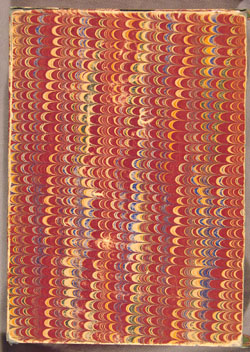
Missale predicator[um] nuper impressum ac emendatum cum multis missis orationibus: pulcherrimisq[ue] figuris i[n] capite missarum festivitatum sele[n]nium de novo superadditis: ut inspicienti patebit. Venice: Luc' Antonio Giunta, 1521. (The Gonzaga Collection: Rare Books from the Jesuit Heritage, Inv. No. M56)
The slipcase of the Dominican Missal of 1521 is entirely marbled, in a pattern which matches the cover and endpapers.

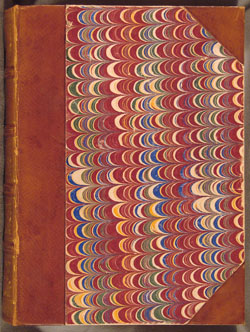
 The marbling continues on the book's endpapers. The bookplate of Stevens Sanderson is seen here; this physician's widow donated this valuable missal and the Roman Missal of 1484 to the Jesuit scholasticate at Mount St. Michael's and thence it came to Gonzaga University with the rest of The Gonzaga Collection. Following the colorful front endpapers are three blank flyleaves.
The marbling continues on the book's endpapers. The bookplate of Stevens Sanderson is seen here; this physician's widow donated this valuable missal and the Roman Missal of 1484 to the Jesuit scholasticate at Mount St. Michael's and thence it came to Gonzaga University with the rest of The Gonzaga Collection. Following the colorful front endpapers are three blank flyleaves.
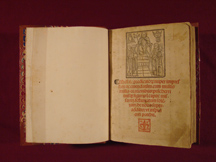
The title page features a large woodcut showing St. Dominic, founder of the Dominican order, holding a flowering lily in his right hand and teaching from a book open on his knee. In the upper left is depicted Christ in heaven, in the upper right an angel bearing a triple crown. Note the woman at the right among the four haloed Dominican saints, each holding a book, indicating their theological learning.
The Giunta family was a publishing dynasty, with presses in Florence, Venice and Lyons and bookshops in several cities.2 Luc' Antonio Giunta (1457-1538) published this volume, as is stated in the book's colophon and as is shown on the title page by his personal printing device, the square-framed symbol at the base of the title. The lily represents Florence and his initials, L. and A., flank the flower.
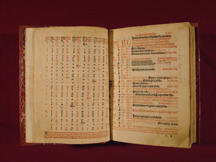 As usual, the liturgical calendar comes right after the title page. The lefthand page provides a table for calculating the date each year for Easter and several other major feasts including Ash Wednesday, Ascension, Pentecost, and Corpus Christi, based on the Julian calendar. (The scientific Gregorian calendar reform occurred in 1582). The first column begins with the Golden Number, used in these calculations. The calendar follows, one page per month, with red ink used to indicate important feast days.
As usual, the liturgical calendar comes right after the title page. The lefthand page provides a table for calculating the date each year for Easter and several other major feasts including Ash Wednesday, Ascension, Pentecost, and Corpus Christi, based on the Julian calendar. (The scientific Gregorian calendar reform occurred in 1582). The first column begins with the Golden Number, used in these calculations. The calendar follows, one page per month, with red ink used to indicate important feast days.
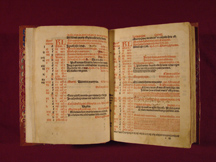 February and March. In February, the feast of St. Blase was identified in print here as "Simplex" (the lowest level of feast), but has been corrected by hand to "Duplex" (a higher level). In March, above St. Benedict, a St. Joachim has been added by hand.
February and March. In February, the feast of St. Blase was identified in print here as "Simplex" (the lowest level of feast), but has been corrected by hand to "Duplex" (a higher level). In March, above St. Benedict, a St. Joachim has been added by hand.
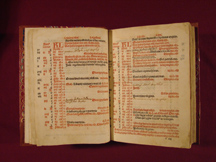 April and May. Notice the "bleed through" of the sepia ink on the lefthand page.
April and May. Notice the "bleed through" of the sepia ink on the lefthand page.
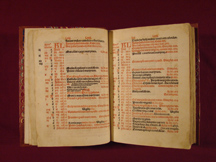 June and July.
June and July.
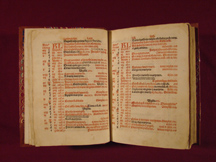 August and September.
August and September.
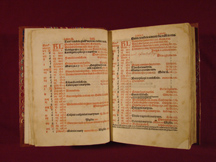 October and November. An entry has been added by hand in red ink: "Caroli ep[iscop]i et conf[essoris]. Duplex" (Charles, bishop and confessor. Duplex). (The genitive is used because this is the feast of Charles....)
October and November. An entry has been added by hand in red ink: "Caroli ep[iscop]i et conf[essoris]. Duplex" (Charles, bishop and confessor. Duplex). (The genitive is used because this is the feast of Charles....)
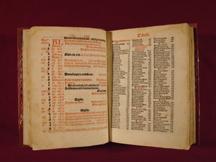 The calendar concludes with December on the lefthand page and the "Tabula" of the book's contents starts on the righthand page. In this table, and in the prefatory texts to follow, red is used for headings. The book was numbered in Arabic numbers by the printer, starting with the first page of the Missal proper (The Annunciation, some pages below). The numbers in the Table of Contents refer to folios.
The calendar concludes with December on the lefthand page and the "Tabula" of the book's contents starts on the righthand page. In this table, and in the prefatory texts to follow, red is used for headings. The book was numbered in Arabic numbers by the printer, starting with the first page of the Missal proper (The Annunciation, some pages below). The numbers in the Table of Contents refer to folios.
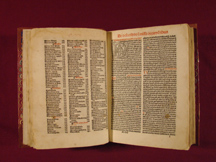 The Table of contents concludes on the lefthand page, ending with "extraordinary masses." Note the inclusion here of righteous figures from the Old Testament, St. Job and St. Daniel. On the righthand page begins the first prefatory text, "De defectibus i[n] missa accure[n]-tibus" (Concerning defects that may occur during the mass).
The Table of contents concludes on the lefthand page, ending with "extraordinary masses." Note the inclusion here of righteous figures from the Old Testament, St. Job and St. Daniel. On the righthand page begins the first prefatory text, "De defectibus i[n] missa accure[n]-tibus" (Concerning defects that may occur during the mass).
 Headings in red indicate that defects treated on this opening include problems with the water, the form, the celebrant's intention, and the vestments.
Headings in red indicate that defects treated on this opening include problems with the water, the form, the celebrant's intention, and the vestments.
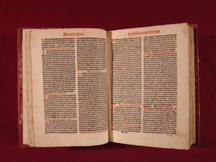 Problems with disposition of body and soul are treated on the lefthand page, and, on the righthand page, what to do when the host falls ("Q[ua]n[do] cadit corpus christi" and "Quando cadit sanguis christi").
Problems with disposition of body and soul are treated on the lefthand page, and, on the righthand page, what to do when the host falls ("Q[ua]n[do] cadit corpus christi" and "Quando cadit sanguis christi").
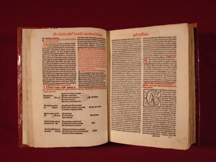 Even the case of how to proceed when the wine has been poisoned is treated. The table on the lefthand page presents various circumstances and the proper actions. Note the sepia lines added by hand to the table. On the opposite page the woodcut of a monk fills the initial G of "Gratias tibi ago domine" (I give thanks to thee, O Lord"), at the start of the discussion of prayers after the mass.
Even the case of how to proceed when the wine has been poisoned is treated. The table on the lefthand page presents various circumstances and the proper actions. Note the sepia lines added by hand to the table. On the opposite page the woodcut of a monk fills the initial G of "Gratias tibi ago domine" (I give thanks to thee, O Lord"), at the start of the discussion of prayers after the mass.
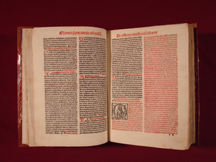 On the righthand page begins "De officio ministroru[m] altaris" (Concerning the office of the ministers of the altar). Here red ink is used for directions, and black ink is used for words actually to be spoken by the priest. The woodcut shows a haloed, bearded man with a book within the initial Q, beginning the phrase "Quando missa in conventu..." (When the mass [is celebrated] in a convent...).
On the righthand page begins "De officio ministroru[m] altaris" (Concerning the office of the ministers of the altar). Here red ink is used for directions, and black ink is used for words actually to be spoken by the priest. The woodcut shows a haloed, bearded man with a book within the initial Q, beginning the phrase "Quando missa in conventu..." (When the mass [is celebrated] in a convent...).
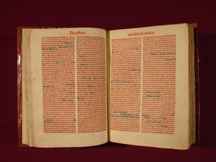 The directions continue, from "Asperges me" through the Creed and Gloria....
The directions continue, from "Asperges me" through the Creed and Gloria....
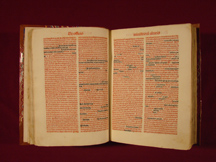 ... through the Our Father...
... through the Our Father...
 ... through the "Agnus Dei" and the beginning of directions concerning "Gloria in excelsis." The diagrams on the lefthand page show how the circular eucharistic host represents the crucified Christ, and the fraction of the host.
... through the "Agnus Dei" and the beginning of directions concerning "Gloria in excelsis." The diagrams on the lefthand page show how the circular eucharistic host represents the crucified Christ, and the fraction of the host.
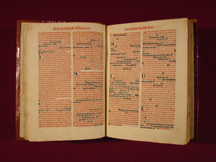 Variations from the "Gloria" onwards...
Variations from the "Gloria" onwards...
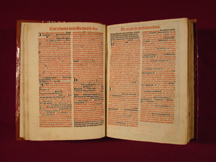 The direction concludes with variations in concluding mass for special feasts (e.g., Annunciation, Visitation, Nativity.
The direction concludes with variations in concluding mass for special feasts (e.g., Annunciation, Visitation, Nativity.
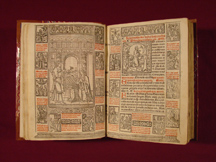 Here the missal proper begins, and likewise the first folio number, 1, appears in the upper righthand corner of the opening. The words in red atop the righthand page identify the feast: "D[omi]nica P[ri]ma in adve[n]tu d[omi]ni (The First Sunday in the Advent of the Lord). The Annunciation is depicted in the major woodcut on the left page, and on the right page the largest woodcut is a special initial to start the first antiphon of the feast (Ps. 24:1). The image shows King David kneeling in prayer, his crown on the ground beside him, in the A of "Ad te levavi animam meam deus meus. in te confido. non erubesca[m]...."
Here the missal proper begins, and likewise the first folio number, 1, appears in the upper righthand corner of the opening. The words in red atop the righthand page identify the feast: "D[omi]nica P[ri]ma in adve[n]tu d[omi]ni (The First Sunday in the Advent of the Lord). The Annunciation is depicted in the major woodcut on the left page, and on the right page the largest woodcut is a special initial to start the first antiphon of the feast (Ps. 24:1). The image shows King David kneeling in prayer, his crown on the ground beside him, in the A of "Ad te levavi animam meam deus meus. in te confido. non erubesca[m]...."
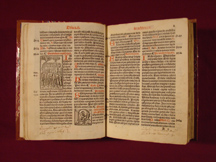 The Entry into Jerusalem. A woodcut depicting the Gospel lection from Matthew is in the left column: Christ stands beside an ass on which a garment has been laid as a seat, amid a crowd. (For a large miniature of this event, see below, fol. 63v.) In the right column of that page is a woodcut P at the start of the word "Populus" (People). Handwritten notes in sepia ink are at the base of the first column here and at the base of the second column on folio 2.
The Entry into Jerusalem. A woodcut depicting the Gospel lection from Matthew is in the left column: Christ stands beside an ass on which a garment has been laid as a seat, amid a crowd. (For a large miniature of this event, see below, fol. 63v.) In the right column of that page is a woodcut P at the start of the word "Populus" (People). Handwritten notes in sepia ink are at the base of the first column here and at the base of the second column on folio 2.
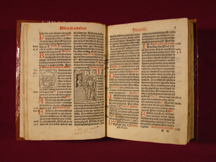 On folio 2v in the left column is a woodcut initial G of "Gaudete" ("Rejoice"). In the right column on that folio is a woodcut illustrating the Gospel lection: John the Baptist in prison, telling two ofHis disciples to go to Jesus, as described in Matthew.
On folio 2v in the left column is a woodcut initial G of "Gaudete" ("Rejoice"). In the right column on that folio is a woodcut illustrating the Gospel lection: John the Baptist in prison, telling two ofHis disciples to go to Jesus, as described in Matthew.
 The evangelist portrait of Luke (with an ox in the foreground) appears beside the lection recounting the Annunciation (Luke 1:26-38).3
The evangelist portrait of Luke (with an ox in the foreground) appears beside the lection recounting the Annunciation (Luke 1:26-38).3
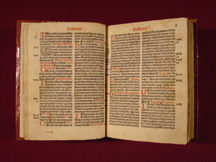 A floreate initial V begins the chant on fol. 4v: "Veni et oste[n]de nobis facie[m] tua[m] d[omi]ne: qui sedes super cherubin [et] salvi erimus. V[ersus]: Qui regis israel inte[n]de: qui deducis velut ovem ioseph." Note the marginal identification of the biblical source of these verses: Ps[almum] 79" and "ibide[m]," that is, "the same psalm."
A floreate initial V begins the chant on fol. 4v: "Veni et oste[n]de nobis facie[m] tua[m] d[omi]ne: qui sedes super cherubin [et] salvi erimus. V[ersus]: Qui regis israel inte[n]de: qui deducis velut ovem ioseph." Note the marginal identification of the biblical source of these verses: Ps[almum] 79" and "ibide[m]," that is, "the same psalm."
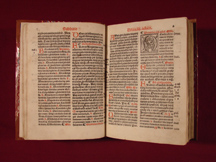 Saints Peter and Paul together fill the M of "Memento..." (Psalm 105:4). St. Paul holds the sword by which he was beheaded, and Peter holds a book and the keys of the kingdom of heaven.
Saints Peter and Paul together fill the M of "Memento..." (Psalm 105:4). St. Paul holds the sword by which he was beheaded, and Peter holds a book and the keys of the kingdom of heaven.
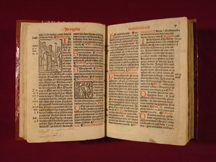 The first woodcut on the lefthand page illustrates the lection, showing John the Baptist telling the people he is not the Christ. The second woodcut is an historiated initial H beginning "Hodie scietis q[uia] veniet dominus et salvabit nos" (Gradual Psalm). The initial holds a turbaned man who gestures with his left hand, index finger upraised. This gesture is a standard way for artists to indicate speech.
The first woodcut on the lefthand page illustrates the lection, showing John the Baptist telling the people he is not the Christ. The second woodcut is an historiated initial H beginning "Hodie scietis q[uia] veniet dominus et salvabit nos" (Gradual Psalm). The initial holds a turbaned man who gestures with his left hand, index finger upraised. This gesture is a standard way for artists to indicate speech.
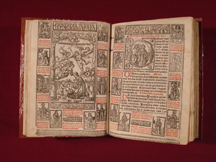 "In nocte natalis Domini" (On the night of the nativity of the Lord") provides the next fully decorated opening.
"In nocte natalis Domini" (On the night of the nativity of the Lord") provides the next fully decorated opening.
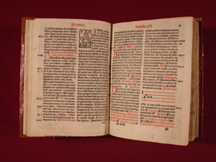 Gregorian chant in musical notation appears on the righthand page, setting the tone for chanting the "Gloria."
Gregorian chant in musical notation appears on the righthand page, setting the tone for chanting the "Gloria."
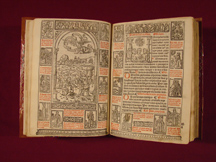 The angels' annunciation to the shepherds is shown in the large woodcut here. The righthand page is headed "In aurora ad missam. Officium," and the first text is the chant "Lux fulgebit hodie super nos quia natus est nobis Dominus" (Light flashes forth today upon us because the Lord is born for us). To begin the glorious word "Lux" on this feast, a special woodcut appears, for the letter L but also depicting a coruscating star of light.
The angels' annunciation to the shepherds is shown in the large woodcut here. The righthand page is headed "In aurora ad missam. Officium," and the first text is the chant "Lux fulgebit hodie super nos quia natus est nobis Dominus" (Light flashes forth today upon us because the Lord is born for us). To begin the glorious word "Lux" on this feast, a special woodcut appears, for the letter L but also depicting a coruscating star of light.
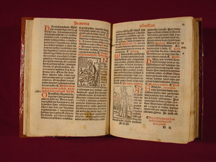 The woodcut on the lefthand page shows the Evangelist Luke seated at a lectern writing his gospel, the source of the chant which is beside the woodcut: "Pastores loquebantur ad invicem" (The shepherds talked one to the other, Luke 2:15). St. Anastasia, whose name means "Resurrection," was martyred on Christmas day; she is depicted in the woodcut on the righthand page, beside a prayer invoking her. In Rome this feast was celebrated by the pope at the church commemorating her.4
The woodcut on the lefthand page shows the Evangelist Luke seated at a lectern writing his gospel, the source of the chant which is beside the woodcut: "Pastores loquebantur ad invicem" (The shepherds talked one to the other, Luke 2:15). St. Anastasia, whose name means "Resurrection," was martyred on Christmas day; she is depicted in the woodcut on the righthand page, beside a prayer invoking her. In Rome this feast was celebrated by the pope at the church commemorating her.4
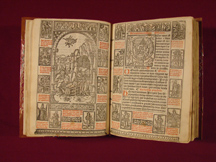 The adoration of the shepherds is shown in the large woodcut on the lefthand page. Although the small woodcut initials used to begin some texts are as a rule unrelated to the content of those texts, for major feasts large woodcut initials specific to the feast were designed. Here on the righthand page, a full nativity scene is within the initial P beginning the word "Puer" (boy), the first word of a chant sung throughout Christmastide.
The adoration of the shepherds is shown in the large woodcut on the lefthand page. Although the small woodcut initials used to begin some texts are as a rule unrelated to the content of those texts, for major feasts large woodcut initials specific to the feast were designed. Here on the righthand page, a full nativity scene is within the initial P beginning the word "Puer" (boy), the first word of a chant sung throughout Christmastide.
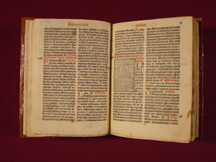 The Evangelist John is depicted on the righthand page in a woodcut prefacing the famous lection which begins his Gospel: "In principio erat Verbum" (In the beginning was the Word).
The Evangelist John is depicted on the righthand page in a woodcut prefacing the famous lection which begins his Gospel: "In principio erat Verbum" (In the beginning was the Word).
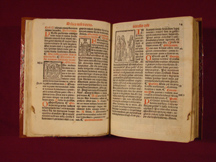 The lefhand page has an initial "D" beginning the word "Dum" and also a woodcut depicting the Apostle Paul, prefacing the lection from one of his epistles, Galatians 4:1-7. The infant Lord's encounter with Symeon in the Temple is depicting in the woodcut prefacing the Gospel lection of that event, Luke 2.
The lefhand page has an initial "D" beginning the word "Dum" and also a woodcut depicting the Apostle Paul, prefacing the lection from one of his epistles, Galatians 4:1-7. The infant Lord's encounter with Symeon in the Temple is depicting in the woodcut prefacing the Gospel lection of that event, Luke 2.
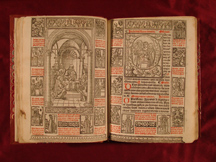 The Circumcision of the Lord is depicted in the large miniature, and again the initial P of "Puer" is specific to the occasion, for the infant Christ is shown standing and returning toHis mother after the ceremony. Note that the heading on the righthand page has an "n" in the second word: "In circuncisione domini." The large miniature includes a young woman at the right holding a basket of doves in one hand and in the other hand a tall lighted candle.
The Circumcision of the Lord is depicted in the large miniature, and again the initial P of "Puer" is specific to the occasion, for the infant Christ is shown standing and returning toHis mother after the ceremony. Note that the heading on the righthand page has an "n" in the second word: "In circuncisione domini." The large miniature includes a young woman at the right holding a basket of doves in one hand and in the other hand a tall lighted candle.
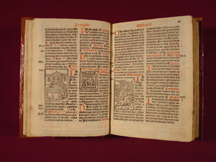 Woodcuts on the lefthand page are a portrait (Luke), and, in a special initial L for the word "Lux" in a Christmas chant, an angel proclaiming "Gloria" to the shepherds.5 On the righthand page, an angel warns Joseph in a dream to take Mary and the Child into safety in Egypt (Matthew 2:13ff.).
Woodcuts on the lefthand page are a portrait (Luke), and, in a special initial L for the word "Lux" in a Christmas chant, an angel proclaiming "Gloria" to the shepherds.5 On the righthand page, an angel warns Joseph in a dream to take Mary and the Child into safety in Egypt (Matthew 2:13ff.).
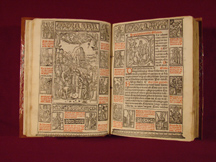 Epiphany is decorated with woodcuts of the Adoration of the Magi: The large woodcut on the lefthand page, the historiated initial E of "Ecce advenit d[omi]nator d[omi]n[u]s et regnum in manu eius..." on the righthand page, and again on the following opening...
Epiphany is decorated with woodcuts of the Adoration of the Magi: The large woodcut on the lefthand page, the historiated initial E of "Ecce advenit d[omi]nator d[omi]n[u]s et regnum in manu eius..." on the righthand page, and again on the following opening...
 ...the woodcut illustrating the Gospel lection it prefaces. On the righthand page the first woodcut is the initial I of "In excelso throno" and it depicts a male saint with a crucifix beside him, holding a book and a flower. In the right column the woodcut illustrates the Gospel lection beside it and shows Mary and Joseph finding the twelve-year-old Jesus teaching the Elders in the Temple.
...the woodcut illustrating the Gospel lection it prefaces. On the righthand page the first woodcut is the initial I of "In excelso throno" and it depicts a male saint with a crucifix beside him, holding a book and a flower. In the right column the woodcut illustrates the Gospel lection beside it and shows Mary and Joseph finding the twelve-year-old Jesus teaching the Elders in the Temple.
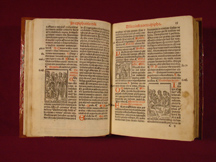 The woodcut on fol. 18v provides the initial E of "Ecce advenit dominatur dominus." Jesus is depicted being baptized in the Jordan by John the Baptist on fol. 19, prefacing the Gospel recounting that: "Venit iesu a galilea in iordanem ad ioan[n]em" (Matthew 3:13-17).
The woodcut on fol. 18v provides the initial E of "Ecce advenit dominatur dominus." Jesus is depicted being baptized in the Jordan by John the Baptist on fol. 19, prefacing the Gospel recounting that: "Venit iesu a galilea in iordanem ad ioan[n]em" (Matthew 3:13-17).
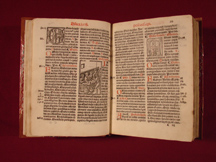 An initial O begins fol. 19v, filled with the image of a vested priest before an altar with a cross on its front. The letter begins the chant "Omnis t[er]ra adoret te de[us] et psallat tibi" (Ps. 65:1-2). The Wedding at Cana is depicted beside the start of John's account of that event (John 2:1-11). The historiated initial A on fol. 20 contains a tonsured man, right hand raised in speech. The intial begins the antiphon "Adorate deum omnes angeli eius: audivit et letata est syon: [et] exultaverunt filie iude" (Psalm 96:7-8). The verse of this chant is Psalm 96:1.
An initial O begins fol. 19v, filled with the image of a vested priest before an altar with a cross on its front. The letter begins the chant "Omnis t[er]ra adoret te de[us] et psallat tibi" (Ps. 65:1-2). The Wedding at Cana is depicted beside the start of John's account of that event (John 2:1-11). The historiated initial A on fol. 20 contains a tonsured man, right hand raised in speech. The intial begins the antiphon "Adorate deum omnes angeli eius: audivit et letata est syon: [et] exultaverunt filie iude" (Psalm 96:7-8). The verse of this chant is Psalm 96:1.
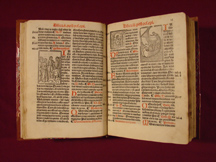 Jesus is shown healing a leper on fol. 20v, beside the lection beginning "Cum desce[n]disset iesus de mo[n]te" (Matthew 8:1-13). On the next page, in the initial A of "Adorate deum o[mn]es (the same antiphon as on fol. 20), a half-length king prays. The Gospel woodcut shows Jesus calming the storm-tossed sea, beside the description of this event in Matthew 8:23-27, beginning "Asce[n]dente iesu in naviculam secuti sunt eum discipuli ei[us]."
Jesus is shown healing a leper on fol. 20v, beside the lection beginning "Cum desce[n]disset iesus de mo[n]te" (Matthew 8:1-13). On the next page, in the initial A of "Adorate deum o[mn]es (the same antiphon as on fol. 20), a half-length king prays. The Gospel woodcut shows Jesus calming the storm-tossed sea, beside the description of this event in Matthew 8:23-27, beginning "Asce[n]dente iesu in naviculam secuti sunt eum discipuli ei[us]."
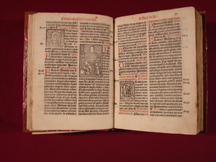 The same initial "A" seen on fol. 21 is repeated on fol. 21v, with the same text, although here with no abbreviations. The evangelist portrait of Matthew appears for the first time in the missal here, prefacing a parable of the kingdom of God recounted in Matthew 13:24-30. It recounts the sowing of good seed, but the enemy sowing weeds in the night. In the initial C of "Circu[m]dederunt me gemit[us] mortis" (Psalm 17:5-7) is a half-length portrait of St. Lawrence, holding up a gridiron, the instrument of his third-century martyrdom in Rome. He appears in the missal here, because on the third Sunday before Ash Wednesday the pope would celebrate mass at his church in Rome.
The same initial "A" seen on fol. 21 is repeated on fol. 21v, with the same text, although here with no abbreviations. The evangelist portrait of Matthew appears for the first time in the missal here, prefacing a parable of the kingdom of God recounted in Matthew 13:24-30. It recounts the sowing of good seed, but the enemy sowing weeds in the night. In the initial C of "Circu[m]dederunt me gemit[us] mortis" (Psalm 17:5-7) is a half-length portrait of St. Lawrence, holding up a gridiron, the instrument of his third-century martyrdom in Rome. He appears in the missal here, because on the third Sunday before Ash Wednesday the pope would celebrate mass at his church in Rome.
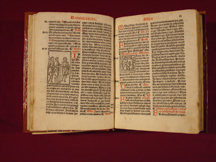 The parable of the vineyard workers, with each being paid the same, is depicted in the woodcut here (fol. 22v): The owner speaks to two workmen with tools. (Matthew 20:1-16). Although the text requires an initial E on fol. 23, the letter appears to be an A. In it an executioner stands with sword raised behind a kneeling, haloed, praying man. The text is "Exurge, q[ua]re obdormis, d[omi]ne: exurge et ne repellas" (Psalm 43:23).
The parable of the vineyard workers, with each being paid the same, is depicted in the woodcut here (fol. 22v): The owner speaks to two workmen with tools. (Matthew 20:1-16). Although the text requires an initial E on fol. 23, the letter appears to be an A. In it an executioner stands with sword raised behind a kneeling, haloed, praying man. The text is "Exurge, q[ua]re obdormis, d[omi]ne: exurge et ne repellas" (Psalm 43:23).
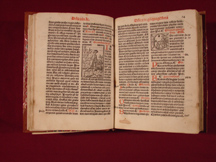
The parable of the good seed is comprehensively conveyed through the woodcut prefacing the Gospel lection: A man sows seed from a wicker basket, while two birds eat some of the seed, some of the ground is stony, and tall weeds rise at left and right. The text is "Cum turba plurima [con]veniret et de civitatib[us] ... dixit per similitudinem ... seminat seminare..." (Luke 8:4-15). An historiated initial begins the text "Esto mihi in deum p[ro]tectorem" (Ps. 30 and 7). In that initial is depicted a monk praying, being blessed by another monk standing before him.
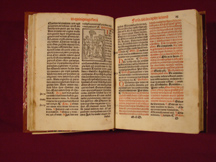 Jesus is depicted addressingHis disciples. He stands at left, and four men stand at right, attending. In the background between them is a tree. The Gospel lection recounts first the Lord's foretellingHis Passion to the disciples, and then the healing of a blind man: "Assumpsit iesus duodeci discipulos suos: [et] ait illis, Ecce asce[n]di[us] hierosolymam et consummabu[n]tur..." (Luke 18:31-43). On the righthand page (fol. 15) many directions for Ash Wednesday are included in red.
Jesus is depicted addressingHis disciples. He stands at left, and four men stand at right, attending. In the background between them is a tree. The Gospel lection recounts first the Lord's foretellingHis Passion to the disciples, and then the healing of a blind man: "Assumpsit iesus duodeci discipulos suos: [et] ait illis, Ecce asce[n]di[us] hierosolymam et consummabu[n]tur..." (Luke 18:31-43). On the righthand page (fol. 15) many directions for Ash Wednesday are included in red.
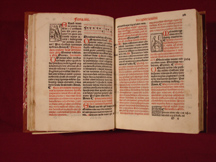 The woodcut starting fol. 25v is probably specific to Ash Wednesday: it shows a tonsured priest standing, praying, before an altar marked with a cross, above which is a statue (?). The musical score gives the chant tone for Ash Wednesday for "Dominus vobiscum" and "Oremus" ("The Lord be with you" and "Let us pray"). On the righthand page (fol. 26) is a beautiful coordination of rubrics, woodcut, and liturgical text: The rubrics describe the priest putting ashes in the sign of the cross on the heads of the faithful, and the woodcut shows a vested priest putting ashes on the crown of the head of a kneeling man (not, one notes, on his forehead). Beside the image are the words the priest speaks at that moment: "Memento q[uod] cines es et in cinerem reverteris" (Remember that you are ashes and into ashes you shall return).
The woodcut starting fol. 25v is probably specific to Ash Wednesday: it shows a tonsured priest standing, praying, before an altar marked with a cross, above which is a statue (?). The musical score gives the chant tone for Ash Wednesday for "Dominus vobiscum" and "Oremus" ("The Lord be with you" and "Let us pray"). On the righthand page (fol. 26) is a beautiful coordination of rubrics, woodcut, and liturgical text: The rubrics describe the priest putting ashes in the sign of the cross on the heads of the faithful, and the woodcut shows a vested priest putting ashes on the crown of the head of a kneeling man (not, one notes, on his forehead). Beside the image are the words the priest speaks at that moment: "Memento q[uod] cines es et in cinerem reverteris" (Remember that you are ashes and into ashes you shall return).
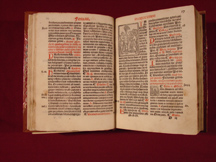 To illustrate the Gospel lection in which Jesus teaches the faithful to fast without ostentation appears the same woodcut seen on fol. 24v. The text is "Dixit iesus discipul[is] suis: cum ieiunatis, nolite fieri ... Ubi est enim thesaurus tu[us]..." (Matthew 6:16-21). An historiated initial D begins the text "Dum clamarem ad d[omi]n[u]m exaudivit vocem meum" (Psalm 54).
To illustrate the Gospel lection in which Jesus teaches the faithful to fast without ostentation appears the same woodcut seen on fol. 24v. The text is "Dixit iesus discipul[is] suis: cum ieiunatis, nolite fieri ... Ubi est enim thesaurus tu[us]..." (Matthew 6:16-21). An historiated initial D begins the text "Dum clamarem ad d[omi]n[u]m exaudivit vocem meum" (Psalm 54).
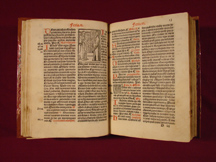 The encounter between Jesus and the Centurion in Capharnaum is depicted beside Matthew's account of this miracle: "Cu[m] introisset iesus capharnaum ... in illa hora "(Matthew 8:5-13). On fol. 28, a floreate initial A begins "Audivit d[omi]n[u]s" (Psalm 29).
The encounter between Jesus and the Centurion in Capharnaum is depicted beside Matthew's account of this miracle: "Cu[m] introisset iesus capharnaum ... in illa hora "(Matthew 8:5-13). On fol. 28, a floreate initial A begins "Audivit d[omi]n[u]s" (Psalm 29).
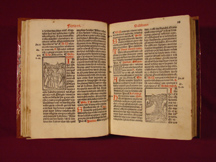 A different woodcut from the one on fols. 24v and 27 is used here to show Jesus teachingHis disciples. It accompanies the lection on loving one's neighbor as oneself. This woodcut places the Lord to the right and the disciples to the left; in the background is a city. The lection begins, "Dixit iesus discipul[is] suis: Audistis q[uia] dictu[m] est antiq[ui]s: Diliges p[ro]ximu[m] tuum: et odio ... et pater tuus qui ..." (Matthew 5:43-6:4). Jesus is shown calming a storm at sea on fol. 29. The lection treats this and also several healings:9 "Cu[m] sero ess[et] factum: erat navis i[n] medio maris ... et quotquot tangeba[n]t eu[m] salvi fiebant" (Mark 6:47-56).
A different woodcut from the one on fols. 24v and 27 is used here to show Jesus teachingHis disciples. It accompanies the lection on loving one's neighbor as oneself. This woodcut places the Lord to the right and the disciples to the left; in the background is a city. The lection begins, "Dixit iesus discipul[is] suis: Audistis q[uia] dictu[m] est antiq[ui]s: Diliges p[ro]ximu[m] tuum: et odio ... et pater tuus qui ..." (Matthew 5:43-6:4). Jesus is shown calming a storm at sea on fol. 29. The lection treats this and also several healings:9 "Cu[m] sero ess[et] factum: erat navis i[n] medio maris ... et quotquot tangeba[n]t eu[m] salvi fiebant" (Mark 6:47-56).
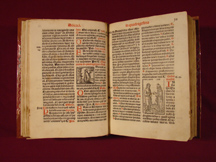 The two woodcuts on this opening make a spiritually coordinated pair. On the left (fol. 29v) the historiated initial I begins the chant "Invocavit me et ego exaudiam eu[m]" (based on Psalm 90:15-16), which recalls that God hears those who call on him. The initial shows a monk kneeling in prayer, gazing up to the face of God in heaven, a traditional way of showing that the one praying is in union with God. On the right (fol. 30) the most famous New Testament temptation is shown: Christ in a cruciform halo stands confronting the horned Devil holding a stone. This woodcut depicts the lection, "Ductus est iesus i[n] desertum a spiritu: et tentaret[ur] a diabolo ... et ecce angeli accesseru[n]t..." (Matthew 4:1-11). The two woodcuts on this opening aligns the monk's aspiration to emulate Christ in resisting temptation, just as had been shown nearly a millennium earlier in the Book of Kells: In that manuscript's large miniature showing the Temptation of Christ, the artist included a throng of monks behind and below Christ, indicating that they, too, intend to resist temptation and serve God alone.6
The two woodcuts on this opening make a spiritually coordinated pair. On the left (fol. 29v) the historiated initial I begins the chant "Invocavit me et ego exaudiam eu[m]" (based on Psalm 90:15-16), which recalls that God hears those who call on him. The initial shows a monk kneeling in prayer, gazing up to the face of God in heaven, a traditional way of showing that the one praying is in union with God. On the right (fol. 30) the most famous New Testament temptation is shown: Christ in a cruciform halo stands confronting the horned Devil holding a stone. This woodcut depicts the lection, "Ductus est iesus i[n] desertum a spiritu: et tentaret[ur] a diabolo ... et ecce angeli accesseru[n]t..." (Matthew 4:1-11). The two woodcuts on this opening aligns the monk's aspiration to emulate Christ in resisting temptation, just as had been shown nearly a millennium earlier in the Book of Kells: In that manuscript's large miniature showing the Temptation of Christ, the artist included a throng of monks behind and below Christ, indicating that they, too, intend to resist temptation and serve God alone.6
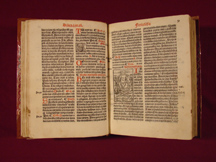 A vegetal initial S starts the text "Sicut oculi servo[rum]" (Psalm 123:2). On the righthand page (fol. 31) the Lord's prophecy of the Last Judgment is depicted in a woodcut before Matthew's account of this prophecy. The image shows Christ, in a cruciform halo, enthroned upon the cherubim,His arms extended and the nail holes inHis palms showing. He is flanked by Mary and John the Baptist; below three raised souls gaze up to the Lord. The Lection reads "Cum venerit filius homines[!] in maiestate sua... [fol. 31v:] iusti autem in vita[m] aeterna[m]" (Matthew 25:31-46).
A vegetal initial S starts the text "Sicut oculi servo[rum]" (Psalm 123:2). On the righthand page (fol. 31) the Lord's prophecy of the Last Judgment is depicted in a woodcut before Matthew's account of this prophecy. The image shows Christ, in a cruciform halo, enthroned upon the cherubim,His arms extended and the nail holes inHis palms showing. He is flanked by Mary and John the Baptist; below three raised souls gaze up to the Lord. The Lection reads "Cum venerit filius homines[!] in maiestate sua... [fol. 31v:] iusti autem in vita[m] aeterna[m]" (Matthew 25:31-46).
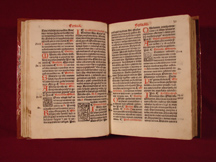 The historiated initial D beginning the text "Domine, refugiu[m] fact[us] es nobis" (Psalm 89) depicts a man's turbaned head. A vivid lection woodcut shows Jesus with a whip chasing the moneychangers from the Temple. The lection: "Cum intrasset iesus hierosolyma[m]: co[m]mota est universa civitas dice[n]s: Qui est hic ... [Fol. 32:] ... Ibiq[ue] docebat eos de regno dei" (Matthew 21:10-17. The final clause is not found in the Greek or the Vulgate, but it is in Gregorian chant and thence it entered this lection in some medieval missals.7 A vegetal initial R is on fol. 32, starting "Reminiscere miserationum tuarum, d[omi]ne" (Psalm 24).
The historiated initial D beginning the text "Domine, refugiu[m] fact[us] es nobis" (Psalm 89) depicts a man's turbaned head. A vivid lection woodcut shows Jesus with a whip chasing the moneychangers from the Temple. The lection: "Cum intrasset iesus hierosolyma[m]: co[m]mota est universa civitas dice[n]s: Qui est hic ... [Fol. 32:] ... Ibiq[ue] docebat eos de regno dei" (Matthew 21:10-17. The final clause is not found in the Greek or the Vulgate, but it is in Gregorian chant and thence it entered this lection in some medieval missals.7 A vegetal initial R is on fol. 32, starting "Reminiscere miserationum tuarum, d[omi]ne" (Psalm 24).
 The lection woodcut (fol. 32v) depicts the scribes and Pharisees asking Jesus for a sign. The lection begins: "Accesseru[n]t ad iesum scribe et pharisei dice[n]tes: Magister volumus a te [fol. 33:] ... signu[m] ione ... ipse frater et soror et mater est" (Matthew 12:38-50). A decorated initial begins the text "Confessio et pulchritudo in conspectu eius" (Psalm 95). A head is depicted within the initial.
The lection woodcut (fol. 32v) depicts the scribes and Pharisees asking Jesus for a sign. The lection begins: "Accesseru[n]t ad iesum scribe et pharisei dice[n]tes: Magister volumus a te [fol. 33:] ... signu[m] ione ... ipse frater et soror et mater est" (Matthew 12:38-50). A decorated initial begins the text "Confessio et pulchritudo in conspectu eius" (Psalm 95). A head is depicted within the initial.
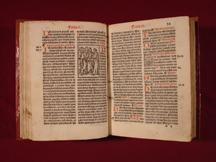 The lection woodcut depicts Jesus speaking with Jews who believe in him as well as others who seek to kill him, as recounted in John 8:31-45). The reading begins: "Dicebat iesus ad eos qui credideru[n]t ei iudeos. Si vos ma[n]seritis in sermone meo ... [fol. 34:] ... Ego aut[em] q[uia] veritatem dico: no[n] creditis mihi." A depiction of Mary, haloed, holding the infant Jesus is in the initial D (on fol. 34) of "De necessitatibus meis eripe me domine..." (Psalm 24).
The lection woodcut depicts Jesus speaking with Jews who believe in him as well as others who seek to kill him, as recounted in John 8:31-45). The reading begins: "Dicebat iesus ad eos qui credideru[n]t ei iudeos. Si vos ma[n]seritis in sermone meo ... [fol. 34:] ... Ego aut[em] q[uia] veritatem dico: no[n] creditis mihi." A depiction of Mary, haloed, holding the infant Jesus is in the initial D (on fol. 34) of "De necessitatibus meis eripe me domine..." (Psalm 24).
The following images were digitized in 2008, for the online exhibition "Treasures from the Vault." Some appear online for the first time here. They provide samples of Gregorian chant music and notable woodcuts.
The images below this point were photographed while supported on a gray acid-free pillow, manipulated to conform to the shape of the open volume. The pillow is visible at the edges of the images. Three of the images have PDFs, the other three do not.
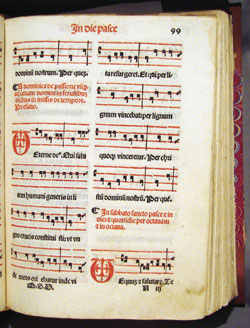 The start of Gregorian chant for Easter is shown here. The page is headed "In die pasce" (On the day of Easter). (Sorry: there is no PDF for this image.)
The start of Gregorian chant for Easter is shown here. The page is headed "In die pasce" (On the day of Easter). (Sorry: there is no PDF for this image.)
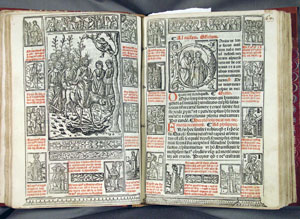 Palm Sunday is featured on this opening, fols. 63v-64. The large miniature on fol. 63v shows Christ's Entry into Jerusalem,His mount treading on the cloak and branches strewn before him by the crowd. On the facing page, Christ is shown with two disciples inside an historiated initial D beginning the antiphon "Domine ne longe facias auxilium tuu[m] a me."
Palm Sunday is featured on this opening, fols. 63v-64. The large miniature on fol. 63v shows Christ's Entry into Jerusalem,His mount treading on the cloak and branches strewn before him by the crowd. On the facing page, Christ is shown with two disciples inside an historiated initial D beginning the antiphon "Domine ne longe facias auxilium tuu[m] a me."
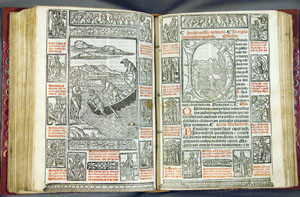 With this opening begins an entire section of the Missal, namely the offices for celebrating the saints. Fittingly, it begins with Christ's calling of Andrew and Peter (Mark 1), and the headpieces on these two pages feature holy men (fol. 155v) and women (fol. 156). The large miniature shows Christ calling to the brothers while they are in their boat, and the unusually large initial D on the facing page shows the next moment, when Andrew has sprung out of the boat toward the Lord to answer the call. Note the portrait woodcut of ANDREAS in the lower right: he holds a tau-cross, on which he was martyred.
With this opening begins an entire section of the Missal, namely the offices for celebrating the saints. Fittingly, it begins with Christ's calling of Andrew and Peter (Mark 1), and the headpieces on these two pages feature holy men (fol. 155v) and women (fol. 156). The large miniature shows Christ calling to the brothers while they are in their boat, and the unusually large initial D on the facing page shows the next moment, when Andrew has sprung out of the boat toward the Lord to answer the call. Note the portrait woodcut of ANDREAS in the lower right: he holds a tau-cross, on which he was martyred.
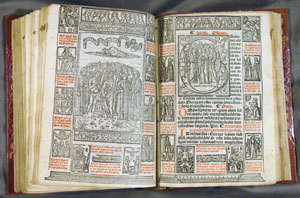 A striking and significant woodcut is used twice in the volume, first for the feast of All Saints (fol. 232v-233). A throng of men and, apparently, women are on a hillside representing Heaven. Overhead a scroll is inscribed with the words that God the Father proclaimed of Christ at His Baptism and again at His Transfiguration, but here the words are made plural: HI SUNT FILII MEI DILECTI (These are my beloved sons).8 To emphasize that both sexes are called to holiness the headpieces here show both female and male saints. (Sorry: there is no PDF for this image.)
A striking and significant woodcut is used twice in the volume, first for the feast of All Saints (fol. 232v-233). A throng of men and, apparently, women are on a hillside representing Heaven. Overhead a scroll is inscribed with the words that God the Father proclaimed of Christ at His Baptism and again at His Transfiguration, but here the words are made plural: HI SUNT FILII MEI DILECTI (These are my beloved sons).8 To emphasize that both sexes are called to holiness the headpieces here show both female and male saints. (Sorry: there is no PDF for this image.)
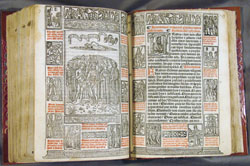
The same miniature is also used in this volume for the feast of one or more apostles. The significance of the miniature is twofold: Vividly it expresses the doctrine that everyone is called to be a son of God. Also, because of the presence of women in the depiction, it is clear that the masculine generic in the quotation is truly generic.9 This is valuable evidence of the Catholic understanding of the spiritual equality of the sexes. (Sorry: there is no PDF for this image.)
The missal concludes with a colophon which names Alberto da Castello, O.P., as the one who revised, corrected and emended the missal "in the most splendid city of the Venetians ("in clarissima venetiaru[m] vrbe"). The work was completed by the art and at the great expense of Luca Antonio da Giunta, Florentine, on 26 March 1521 (arte & impensis Luce antonij de giunta florentini diligentissime impressum feliciter explicit. Anno salutis. 1521. Die. 26. Martij. Laus Deo).
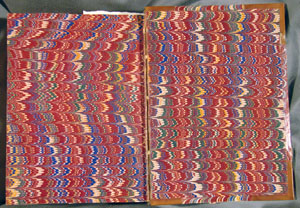 Marbling decorates the endpapers at the back of the volume, as it does those at the front.
Marbling decorates the endpapers at the back of the volume, as it does those at the front.
Dr. Catherine Brown Tkacz, Special Consultant to the President for Rare Books and Manuscripts, August 15, 2009
Notes:
1. The camera is a Sony Cybershot DSC-H5 7.2 MP Digital Camera with 12x Optical Image Stabilization Zoom. Technical details: 7.2 megapixel CCD captures enough detail for photo-quality 15 x 20-inch prints. The camera has a 3.0-inch LCD display; and 12x Super SteadyShot optical image stabilization. Its High Sensitivity Mode (ISO 1000) allows shooting without a flash in low-light conditions. It can capture VGA (640 x 480 audio-video clips at up to 30 frames per second. It has a Carl Zeiss 12x Optical Zoom.
2. Iain Fenlon, James Haar, The Italian Madrigal in the Early Sixteenth Century: Sources and Interpretation (Cambridge: Cambridge University Press, 1988), p. 18, citing Decio Decia and Renato Delfiol, I Giunti: Tipografici editori di Firenze (Florence, 1976) and William A. Pettas, The Giunti of Florence: Merchant Publishers of the Sixteenth Century (San Francisco: B. M. Rosenthal, 1980).
3. The four symbols associated with the four gospel-writers derive from the Bible. Ezekiel's visions and then St. John's Apocalypse describe the same four "living creatures" as surrounding the throne of God: an angel or man, a lion, an ox, and an eagle (Ezekiel 1:1-14 and 10:1-22, Apocalypse 4:7). The early church paired these four creatures with the evangelists, as is seen in St. Jerome's Preface to the Commentary on Matthew. The pairing varied somewhat and then became fixed: Matthew with the angel/man, Mark with the lion, Luke with the ox, and John with the eagle.
4. Michael Kunzler, The Church's Liturgy (New York: Continuum, 2001), p. 416.
5. The angel's banderole reads "GLORIA IN A L," which probably represents the reading from Luke 2:14, "Gloria in altissimis Deo." The familiar liturgical form of "Gloria in excelsis Deo," used in the Dominican Missal in the large woodcut on fol. 9v, evidently combines the angel's annunciation with the shepherd with the concluding phrase of the people's praise when the Lord entered Jerusalem, "Gloria in excelsis" (Luke 19:38).
6. Gonzaga University owns the deluxe facsimile edition of the Book of Kells, so the miniature can be seen in the Rare Books Library upon request. The Temptation of Christ is on fol. 202v of volume 2, of Evangeliorum quattuor Codex Cenannensis auctoritate Collegii Sacrosanctae et Individuae Trinitatis juxta Dublin, facsimile edition in three volumes, authorized by Trinity College, Dublin; ed. Urs Graf, introduction by Ernest Henry Alton (Bern, 1950: U.S. Distributor: New York, Philip C. Duschnes).
7. The composers of Gregorian chant would sometimes combine texts from various scriptures to form a new, coherent chant. Thus the words of Esther, Job, Sarah, and Judith were combined, and so were the words of Susanna, Isaiah, and Paul: Catherine Brown Tkacz, "Singing Women's Words as Sacramental Mimesis," Recherches de Theologie et Philosophie medievales 52.2 (2003): 275-328 at pp. 306 and 311-13. In the same way, it appears that certain chants combined elements from the Matthew lection of interest here with echoes of Luke 9:11, and this led to the Lukan clause actually appearing sometimes in the lection itself.
8. For the words uttered at Christ's Baptism see Matthew 3:17 and Luke 3:22. For the same words at His Transfiguration see Matthew 17:5 and Luke 9:35.
9. As discussed in Tkacz, "Singing Women's Words," pp. 287-88. The same design and inscription as in this woodcut are found in the miniature used with the Office for All Saints Day (fol. 353v?) in a small breviary of the late fifteenth or early sixteenth century: that image is reproduced as Fig. 2.9 on p. 39 in Jaime Lara, Christian Texts for Aztecs: Art and Liturgy in Colonial Mexico (Notre Dame: University of Notre Dame, 2008), where the breviary is identified as owned by the Biblioteca Franciscana, Cholula. Professor David Lyle Jeffrey of Baylor University examined the miniature in the Dominican Missal of 1521 on March 17, 2009 and concurred that women are included in the throng on the hillside.